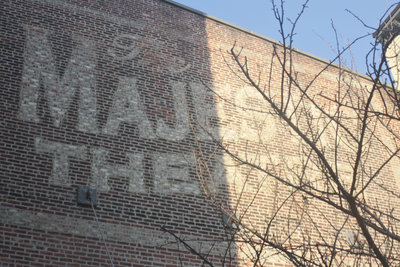They say that the ghosts of actors haunt old theaters, that a special magic lingers in the rafters long after they cease to function as places of art.
Perhaps that is why the lobby of the Majestic Theatre Condominiums in Jersey City still has a vibrant feel to it, and why the work of artists displayed there seems to come alive.
Most people passing the building on Grove Street would hardly realize it was once a theater. Long gone is the marquee, replaced by a storefront. The only remaining signs of its former identity are the ghostly letters painted on the brick wall along the Montgomery Street side.
The building has been converted for residential use, although the lobby was reconstructed to reflect the bygone era of classic movies, complete with small arched spaces along one wall. The stairs to the below street level garage are pretty much unchanged from those days.
The lobby, which is soon to feature work by Paul Lempa, is one of several arts spaces throughout Jersey City provided by Paul and Eric Silverman, who have been crucial in providing support for groups like Art House Productions, the JC Fridays programs, and the annual Artist’s Studio Tour.
Majestic has a sister gallery space across town at the Silverman’s Hamilton Square North development, and the two studios coordinate shows.
The Silvermans aren’t just constructing buildings, they’re building neighborhoods.
____________
Each show runs around four months. But the shows are staggered so that there is a new opening at one or the other gallery every two months.
Paul Lempa’s “Icons of Sports” opened on March 7 and will run until June 28.
Lempa was inspired by an exhibit at the American Folk Art Museum that showed the history of baseball-related art. In a book on the subject, Lempa read about an umpire who used India inks to decorate over 800 baseballs, and this gave him confidence to pursue his own art.
Lempa’s work somehow captures the spirit of the America’s national pastime the way Norman Rockwell did other aspects of American life, each piece catching the tip of some important personal moment of triumph in the characters he conveys.
With baseball season starting shortly, Lempa’s exhibit seems particularly apt, although these galleries often represent a variety of subjects and styles, a diversity reflecting the diverse nature of the Jersey City art scene itself.
Lempa’s work replaces an equally thought-providing exhibit by John Aloysius Patterson, whose images are reminiscent of Jackson Pollack, but with more control and more obvious meaning.
Meanwhile at the Hamilton Square site, works by Michael Meadors will continue to be displayed until May 31. Meadors pieces evoke personal feelings from the characters he displays, and viewers may get the sense that they know these people just from the way each work is done. Part of this is evoked by the tilt of the character’s head or a look in the eye.
Displayed in a bright lobby beneath the high ceilings of Hamilton Park North, the works and space complement each other.
Although both locations make use of historic buildings (Hamilton Park is the site of former St. Francis Hospital), the Majestic gallery space has a much more intimate feel, while the Hamilton Park seemed more like a Soho gallery space.
Both sites had fallen into disrepair prior to the Silverman redevelopment. Although longtime residents of downtown Jersey City might recall the theater’s heyday, the building was largely unused until the redevelopment, and the idea for establishing the galleries came from the former curator of the Jersey City Museum. Carroll, who curates the Silverman shows, has his roots in the still closed Jersey City Museum.
“The idea behind this is that the Silvermans aren’t just constructing buildings,” Wilkins said. “They are building neighborhoods.”
Al Sullivan may be reached at asullivan@hudsonreporter.com.
